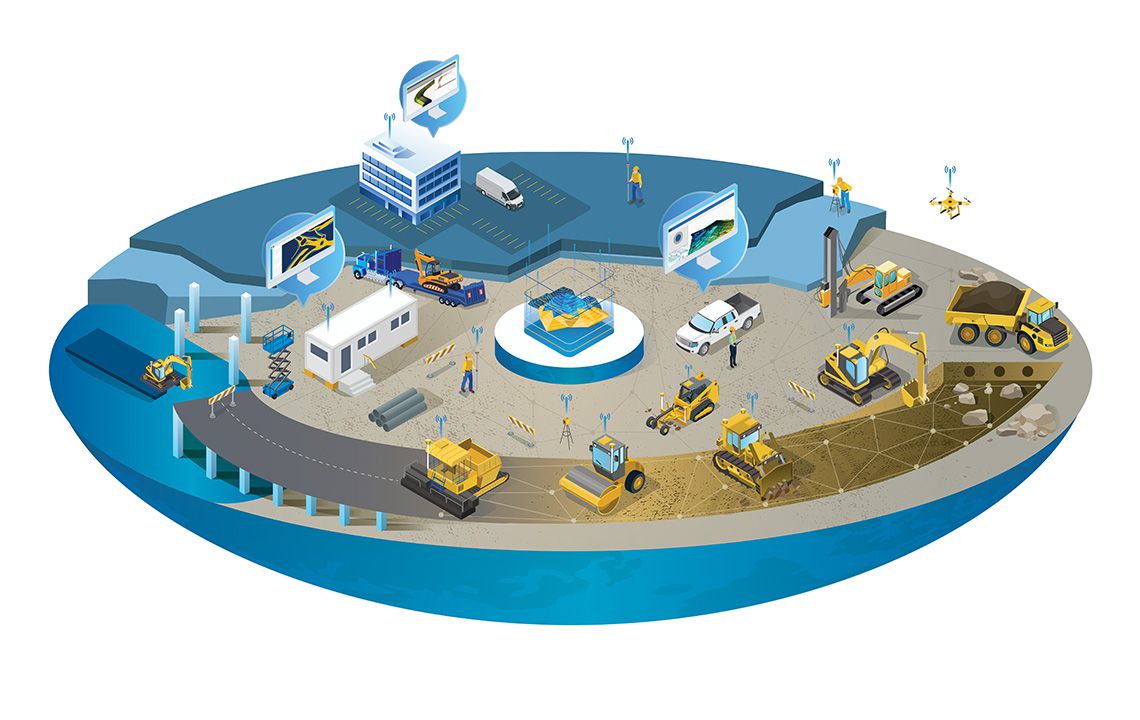Building a connected construction site
Termotex, a construction company in Panama, achieved an amazing 2,000 per cent revenue boost from investing in connected construction technology.
Companies all around the world are realising productivity gains from connecting their sites but, closer to home, it can be difficult to know where to start. Here Ian Barnes, Head of Business at Trimble® machine control specialist SITECH UK & Ireland, shares advice on building a connected construction site.
A fully connected site can provide construction businesses with an overview of an entire project from field to finish — site managers, office workers and operators can use real-time data to stay on top of design changes, project progress and completion deadlines. Connected sites enable quick and easy data management that can skyrocket productivity, reduce lead times and make site to office communication smoother.
Construction site challenges
One of the most common on-site challenges is avoiding human error, particularly during manual processes like collecting measurements. For example, if line guides are not pulled tight when levelling longer distances, the operator will take an inaccurate reading. Manually writing down the results on a clipboard can also cause a delay in data reporting and gives the opportunity for pieces of paper to be misplaced during filing processes.
Another common problem to avoid is over digging; the largest on-site cost for construction companies is moving earth multiple times to fix mistakes. It is also possible that operators unexpectedly interact with underground pipelines that can be costly to move or replace if they get damaged. With costs having risen over the last 20 years, companies have less leeway for unexpected delays.
Additional delays and costs can also be caused by unexpected lead times on materials and equipment as project timings change. It can be difficult to store unused equipment and materials that have been delivered ahead of their scheduled use. On the other hand, if equipment arrives too late, it can cause downtime while waiting for a delivery.
Taking the leap
Once connected site technology has been researched, construction managers can contact technology providers to ask for demonstrations of the technology to see how it performs. Bear in mind that the technology runs off 4G or 5G, so your site will require good cellular connection for data to be transmitted.
We typically find that site managers can very easily overcome the challenges that a fully manual construction site causes, particularly if they have machine hardware that can be retrofitted. Some machinery, such as the Cat 2D E-fence excavator, has monitors and sensors already integrated, which can make the process of getting started even easier. Installing alternative data collection is also simple. Trimble Stratus, powered by Propeller, uses a data analytics and visualisation platform to capture geo-referenced high-resolution aerial images. All operators need to do is lay out their ground control points and then fly the drone over the site. Surveying software like this enables them to access highly accurate topographic surveys and communicate this information to relevant stakeholders. Meanwhile, operators can improve efficiency and accuracy while minimising lead times.
It is then a good idea to loan the technology on a short-term basis to test if it will achieve good return on investment, understand how it will fit into your current operations and assess if the equipment will help you achieve what you set out to do.
Before the technology can be fully integrated on-site, we also recommend consulting a training provider. Connected site technology is highly intuitive, so usually limited training is needed, but site managers may wish for more extensive training to ensure they get the best results from the equipment.

Benefits of a connected site
One benefit our customers realise quickly after adopting machine control technology is that, because connectivity allows information to be transferred sooner, communication is smoother and accuracy is improved. Consider this example; an operator is forming a slope. When pulling their bucket to match the required slope, they can use the Trimble TD520 Control Box to generate audio and visual indicators that say whether they’re cutting to design. By engaging semi-automatic mode, the Trimble Earthworks system will take control of the boom and bucket, ensuring it accurately follows the design.
Our customers can also reduce human error — for example, by using dual GNSS receivers, like the Trimble Earthworks Grade Control Platform, operators can easily see underground pipelines and pre-emptively avoid them during digging, even on steep slopes. This means operators avoid hitting pipelines and unnecessarily moving earth. Think back to the slope example. The Trimble Earthworks system means the operator no longer needs to refer to external profiles or a banksman, reducing the required human input and the possibility for inaccuracies.
Another benefit of the connected site is that data files can be automatically and wirelessly transferred from the site to the office. Managers in the office can easily track the progress of the project and adapt designs to suit changing client needs or to overcome unexpected challenges. Automated design updates reduce the lag time, so that everyone is working to the most up-to-date design, removing the risk of errors occurring from operators working off previous design files. Trimble Earthworks then automatically collates the data and communicates progress to the site manager in the office, which helps streamlines collaboration and minimises miscommunication.
Because data management becomes quick and easy, site managers can reduce lead times for materials and equipment. Managers can integrate a just-in-time method of ordering materials and equipment, so there is no downtime and expensive equipment is used to its full potential.
For those continuing on their digitalisation journey, data management portals can easily combine data from other connected site technology as the site becomes more technology focused. Technologies, such as unmanned aerials vehicles, mobile mapping systems and terrestrial laser scanners can be used to create a unified and fully data led construction site.
Businesses around the world are already realising huge productivity gains from connected technology.



















